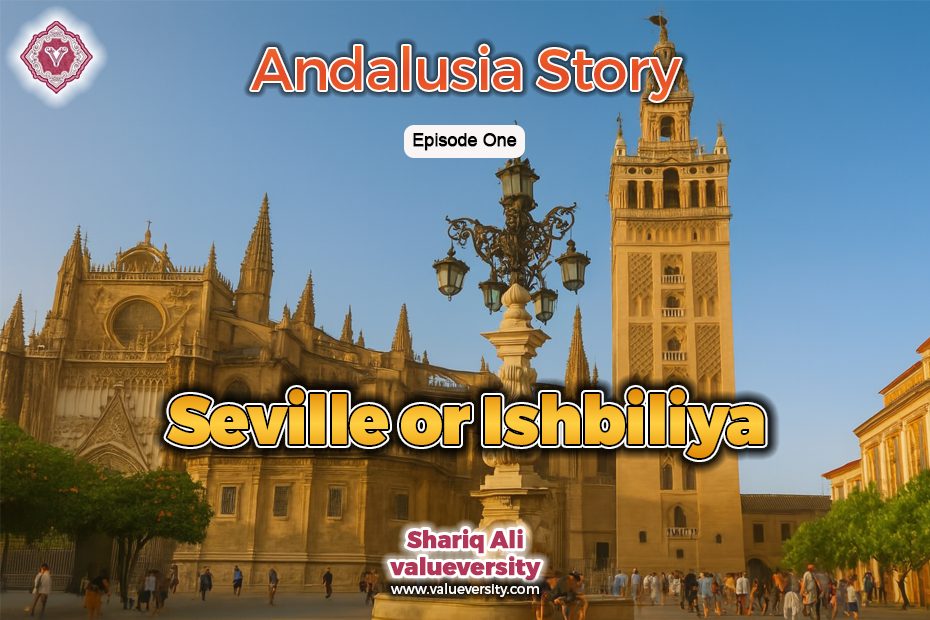Andalusia Story: Episode One – Seville or Ishbiliya
Written by Shariq Ali
Valueversity
The EasyJet Boeing plane was cruising smoothly at high altitude. We departed from London around noon, heading towards the Spanish city of Seville. This is the same city that was known as “Ishbiliya” during the golden era of Muslim rule.
At the beginning of the 8th century, Muslims entered present-day Spain—then known as Al-Andalus—and for nearly eight centuries, knowledge, arts, culture, and tolerance flourished here. From 711 to 1492, Muslim rule extended not only over Spain but also over several areas of present-day Portugal. Cities such as Córdoba, Granada, Ishbiliya (Seville), and Toledo became centers of learning and wisdom, where people of different faiths coexisted and thrived together.
In this travelogue, we will recount the journey through the Spanish cities of Seville, Carmona, and Córdoba—known in Arabic as Ishbiliya, Qarmuna, and Qurtuba. Through this narrative, you will accompany me on this journey. Welcome aboard.
This Andalusia story will contain everyday travel details, but I’ll also try to offer glimpses of the historical wisdom from Andalusia’s golden age. Peeking through the windows of the past, we will also seek to learn from the works of some great thinkers.
History is not merely about wars, conquests, and the clash of swords; its true heroes are the visionary individuals who promoted knowledge, understanding, and human kindness. In this travelogue, we will mention some of those noble figures whose wisdom still twinkles like stars in the sky of human consciousness—such as Ibn Rushd (Averroes), the harmonious voice of reason and faith, and Ibn Khaldun, the keen observer of society and history.
Our flight from London departed at noon, and after adjusting for the two-hour time difference, we landed at Seville Airport around 4 PM. As soon as we stepped off the plane, a warm, dry breeze touched my forehead. It felt as though a nostalgic memory from Sukkur Airport had embraced me. For a brief moment, it seemed as though this wasn’t Seville, but rather the runway of a simple yet clean airport like Hyderabad or Sukkur.
The small airport was handling its operations very efficiently and smoothly. Without any buses, we descended the aircraft stairs and followed the marked lines on the ground, walking straight to immigration. There were no crowds, no chaos. The passport control and baggage procedures were completed pleasantly. It quickly became evident that the locals here are quite warm, friendly, and sociable.
Some Spanish colleagues had already told me that life here is simple but full of aesthetic charm. Great importance is given to food, drink, and spending time with family, which is considered the essence of a beautiful life.
We exited the airport and got into the first taxi in line. Upon giving the address, the taxi driver turned out to be quite familiar with our hotel, Catalonia Santa Justa. Upon arrival, the hotel staff greeted us warmly. The hotel wasn’t very large, but it was comfortable and equipped with all necessary amenities. The rooms were spacious, clean, and tastefully decorated with elegant simplicity.
After placing our luggage in the room and taking a short rest, we walked toward the nearby market. We bought some fruits, dried nuts, and bottled water from local shops to keep basic supplies in the room.
We entered a charming local shop filled with an abundance of fresh fruits and vegetables. Spain’s climate is very favorable for agriculture. Especially famous here are olives, grapes, oranges, apples, and almonds. Spain ranks among Europe’s largest agricultural exporters.
After placing our groceries in the room, we headed towards the city center on foot, following the receptionist’s advice. The city center was just a 10- to 15-minute walk from the hotel. Along the way, we also located the spot outside Hotel de Parco where we were to catch the coach to Córdoba the next day.
Having completed this little mission, we began leisurely strolling through the city center’s streets—partly to soak in the city’s atmosphere and partly to find a nice restaurant for dinner. Using TripAdvisor and Google Maps, we wandered through alleys and eventually reached a bright, lively Arabic restaurant near the Alcázar Palace, clearly marked as Halal.
…To be continued…
